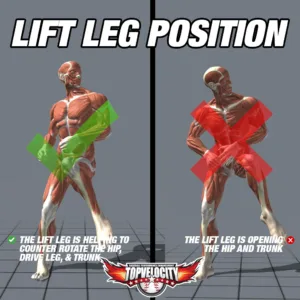 Why do pitchers lift their leg? When it comes to the art of baseball pitching, every movement is a calculated element of a finely-tuned dance, none more critical than the leg lift. This initial motion is not just for show—it's a fundamental component that can dictate the power and speed of a pitch, ultimately influencing the game's outcome. At TopVelocity.net, we delve deep into the nuances of pitching mechanics, and the leg lift is a topic that stands out for its vital role in an athlete’s performance.
Why do pitchers lift their leg? When it comes to the art of baseball pitching, every movement is a calculated element of a finely-tuned dance, none more critical than the leg lift. This initial motion is not just for show—it's a fundamental component that can dictate the power and speed of a pitch, ultimately influencing the game's outcome. At TopVelocity.net, we delve deep into the nuances of pitching mechanics, and the leg lift is a topic that stands out for its vital role in an athlete’s performance.
Keizo Takahashi's enlightening case study sheds light on the kinematic and temporal adjustments that pitchers undergo to perfect their slide step delivery (SSD). This research, conducted with precision and attention to detail, offers valuable insights into the technical tweaks that can make or break a pitcher's efficiency and effectiveness on the mound.
In this article, we aim to unpack the layers behind this pivotal motion. We'll explore the biomechanics of why pitchers lift their leg, the benefits of this action, and the impact it has on their overall delivery. By bridging the gap between scientific study and on-field application, we're set to offer pitchers, coaches, and enthusiasts a deeper understanding of how to harness the power of the leg lift for peak performance.
Join us as we step into the world of high-velocity pitching, where every second counts and the leg lift reigns supreme. It's not just about throwing harder; it's about smarter, safer, and more strategic pitching—powered by evidence-based practice here at TopVelocity.net.
The Mechanics of: Why Do Pitchers Lift Their Leg?
 Decoding Why Do Pitchers Lift Their Leg?
Decoding Why Do Pitchers Lift Their Leg?
When observing a pitcher on the mound, one can see the poetry in motion, and the leg lift is the verse that sets the rhythm. This critical movement is more than a mere start to the pitching delivery; it's the prelude to power and precision. The leg lift involves raising the lead leg to a certain height before transitioning into the stride towards home plate. This action is instrumental in generating the momentum needed to deliver a forceful and effective pitch. The leg lift is not just about lifting the leg; it's about setting the stage for the dynamic sequence of movements that follow.
Breaking Down: Why Do Pitchers Lift Their Leg?
Takahashi's case study provides a scientific breakdown of the pitching delivery into three distinct phases, each critical to the overall effectiveness of a pitch.
- Phase 1: Initial Leg Movement The journey of a thousand miles begins with a single step, and in pitching, that journey begins with the initial leg movement. This first phase is where the pitcher initiates the kinetic chain that will ultimately lead to the pitch. Here, the balance, posture, and timing are set, which will influence the entire pitching motion.
- Phase 2: Stride and Arm Cocking As the pitcher moves into the second phase, the stride and arm cocking come into play. This is where the body begins to engage fully, and the pitcher's arm starts its backward path, preparing for the explosive release of the ball. This phase is critical for aligning the pitcher's body in a direct path to the target.
- Phase 3: Arm Acceleration to Ball Release The final phase is where the stored energy is unleashed. The arm accelerates forward, and the ball is released towards home plate. This is the culmination of a well-orchestrated movement pattern that began with the leg lift.
Understanding Slide Step Delivery (SSD): Why Do Pitchers Lift Their Leg?
 Defining the Slide Step Delivery
Defining the Slide Step Delivery
In the high-stakes world of baseball, every second counts, especially when it comes to pitching. The Slide Step Delivery (SSD) is a pivotal technique used by pitchers to deliver the ball to the catcher with expediency and precision. This approach is characterized by a minimized leg lift, which allows for a quicker transition to the pitch release. The significance of SSD in the game cannot be overstated—it's a strategic move designed to shorten the time it takes for the ball to travel from the mound to home plate, giving baserunners less opportunity to react and steal bases.
SSD: A Strategic Defense Against Stolen Bases
The art of stealing bases is a dynamic aspect of baseball that can turn the tide of any game. To counter this, pitchers employ SSD, a method that serves as a crucial line of defense. By reducing the time taken in the pitching motion, SSD decreases the window for baserunners to successfully steal a base. It's a subtle yet powerful adjustment that enhances a pitcher's ability to control the game's tempo and keep baserunners at bay.
Balancing Quick Delivery with Pitch Velocity
While the advantages of SSD are clear, one of the greatest challenges pitchers face is maintaining a high velocity during this accelerated delivery process. The key to a successful SSD is to not only quicken the delivery but to do so without sacrificing the speed and power of the pitch. This delicate balance is what separates proficient pitchers from the rest. As Takahashi's study suggests, targeted technical training that focuses on the efficient movement of the lower body, specifically the knee lift, can aid pitchers in achieving a swift SSD while preserving, if not enhancing, their pitch velocity.
Become a Part of the Elite: Join TopVelocity Patreon Pro
 Are you ready to elevate your game to the highest level? To transform your pitching from good to great to elite? It’s time to join a community where knowledge meets application, and potential turns into performance. TopVelocity.net invites you to become an exclusive member of our Patreon Pro community, where elite pitching mechanics aren't just discussed—they're developed.
Are you ready to elevate your game to the highest level? To transform your pitching from good to great to elite? It’s time to join a community where knowledge meets application, and potential turns into performance. TopVelocity.net invites you to become an exclusive member of our Patreon Pro community, where elite pitching mechanics aren't just discussed—they're developed.
What Awaits You at TopVelocity Patreon Pro:
- Exclusive Content: Get access to advanced pitching techniques and drills that we don't share anywhere else. This content is crafted to push the boundaries of what you thought possible.
- Personalized Coaching: Receive guidance tailored to your unique pitching style and goals. Our Patreon Pro members get personalized advice that goes beyond the one-size-fits-all approach.
- Community Support: Join a network of like-minded athletes, coaches, and enthusiasts all striving towards the same goal—pitching excellence.
- Behind-the-Scenes Access: Peek behind the curtain of professional pitching with insights and stories from within the locker room and on the field.
- Early Program Releases: Get the first look at our latest programs and updates, allowing you to stay ahead of the competition.
The journey of becoming an elite pitcher is challenging and requires more than just practice—it demands a deep understanding of the mechanics that drive top performance. TopVelocity Patreon Pro is your gateway to unlocking these secrets.
Your Path to the Mound Begins Here:
Whether you're looking to add velocity, refine your mechanics, or learn the intricacies of pitch types, we have the resources and expertise to guide you there. It's time to stop guessing and start applying science-backed strategies to your training regimen.
Don’t miss out on the opportunity to revolutionize your pitching. Visit topvelocity.net/patreon to sign up today and take the first step towards unlocking your true potential on the mound. Join TopVelocity Patreon Pro and throw harder, pitch smarter, and lead the game.
Take the Leap: Join TopVelocity Patreon Pro Now!
FAQ Section for "Why Do Pitchers Lift Their Leg?"
Q: Why is the leg lift important in pitching? A: The leg lift, or leg kick, is crucial in pitching because it initiates the kinetic chain that leads to a powerful pitch. It helps pitchers generate momentum, create balance, and prepare for a forceful and controlled delivery towards home plate.
Q: Can a pitcher still throw hard without a high leg lift? A: Yes, a pitcher can still throw hard without a high leg lift by using a technique called the Slide Step Delivery (SSD). This involves a minimized leg lift, allowing for a quicker transition to pitch release. However, it requires refined mechanics and strength to maintain velocity.
Q: Does the leg lift affect pitch accuracy? A: The leg lift can affect pitch accuracy as it sets the stage for the body's alignment and movement towards the plate. Consistent leg lift height and timing can lead to improved accuracy, while variability can disrupt a pitcher's control.
Q: How does the leg lift prevent stolen bases? A: A quicker leg lift as part of the SSD can reduce the time it takes to deliver the ball to the catcher, making it more difficult for base runners to steal bases due to the shortened window of opportunity.
Q: Are there any risks associated with the leg lift in pitching? A: If not executed properly, the leg lift can lead to mechanical inefficiencies or imbalances, which may increase the risk of injury or reduce the effectiveness of a pitch. Proper training and technique are crucial for minimizing risks.
Q: How can pitchers improve their leg lift technique? A: Pitchers can improve their leg lift technique by working on their overall flexibility, strength, and balance. Drills that focus on the mechanics of the leg lift and lower body movements can also be beneficial. TopVelocity programs offer specialized training to enhance this aspect of pitching.
Q: What's the difference between the leg lift in windup and stretch positions? A: The leg lift in the windup is typically higher and more deliberate, allowing for greater momentum and energy build-up. In contrast, the leg lift from the stretch position, particularly with SSD, is quicker and less pronounced to enable a faster delivery to home plate, especially with runners on base.
Q: Is the leg lift different for every pitcher? A: Yes, the leg lift can vary significantly from pitcher to pitcher based on their style, strategy, and body mechanics. There isn't a one-size-fits-all approach, and each pitcher may find different leg lift techniques that work best for them.
Q: How do pitchers maintain balance during the leg lift? A: Pitchers maintain balance during the leg lift by engaging their core muscles, maintaining a stable posture, and focusing on consistent mechanics. Balance drills and core strengthening exercises can help pitchers improve in this area.
Q: Where can I learn more about effective pitching mechanics? A: For a comprehensive guide to pitching mechanics, you can explore TopVelocity's programs and coaching services. Visit topvelocity.net for detailed information and resources tailored to pitchers of all levels. You can also sign up for the TopVelocity Patreon Pro for exclusive content and personalized coaching.
If you have more questions or need further clarification on pitching mechanics, don't hesitate to reach out to us at TopVelocity.net, where we're dedicated to enhancing your performance on the mound.


 Decoding Why Do Pitchers Lift Their Leg?
Decoding Why Do Pitchers Lift Their Leg? Defining the Slide Step Delivery
Defining the Slide Step Delivery

